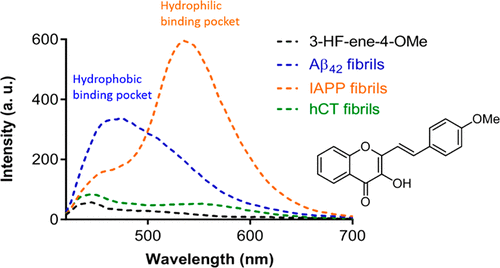当前位置:
X-MOL 学术
›
Biochemistry
›
论文详情
Our official English website, www.x-mol.net, welcomes your
feedback! (Note: you will need to create a separate account there.)
A Fluorogenic Molecule for Probing Islet Amyloid Using Flavonoid as a Scaffold Design.
Biochemistry ( IF 2.9 ) Pub Date : 2020-04-13 , DOI: 10.1021/acs.biochem.0c00076 Wei-Ling Chen,Shih-Ting Ma,Yun-Wen Chen,Yen-Cheng Chao,Ai-Ci Chan,Ling-Hsien Tu,Wei-Min Liu
Biochemistry ( IF 2.9 ) Pub Date : 2020-04-13 , DOI: 10.1021/acs.biochem.0c00076 Wei-Ling Chen,Shih-Ting Ma,Yun-Wen Chen,Yen-Cheng Chao,Ai-Ci Chan,Ling-Hsien Tu,Wei-Min Liu

|
Aggregation of polypeptides and proteins is commonly associated with human and other vertebrate diseases. For example, amyloid plaques consisting of amyloid-β proteins are frequently identified in Alzheimer's disease and islet amyloid formed by islet amyloid polypeptide (IAPP, amylin) can be found in most patients with type 2 diabetes (T2D). Although many fluorescent dyes have been developed to stain amyloid fibrils, very few examples have been designed for IAPP. In this study, a series of environmentally sensitive fluorescent probes using flavonoid as a scaffold design are rationally designed and synthesized. One of these probes, namely 3-HF-ene-4'-OMe, can bind to IAPP fibrils but not nonfibrillar IAPP by exhibiting a much stronger fluorescent enhancement at 535 nm. In addition, this probe shows better detection sensitivity to IAPP fibrils compared with that of conventionally used thioflavin-T. We demonstrate that 3-HF-ene-4'-OMe can be used to monitor the kinetics of IAPP fibril formation in vitro even in the presence an amyloid inhibitor. To test the specificity of the probe, we attempt to incubate this probe with amyloid fibrils formed from other amyloidogenic proteins. Interestingly, this probe shows different responses when mixed with these fibrils, suggesting the mode of binding of this probe on these fibrils could be different. Moreover, we show that this probe is not toxic to pancreatic mouse β-cells. Further structural optimization based on the structure of 3-HF-ene-4'-OMe may yield a specific probe for imaging islet amyloid in the pancreas. That would improve our understanding of the relationship between islet amyloid and T2D.
中文翻译:

一种使用类黄酮作为支架设计探测胰岛淀粉样蛋白的荧光分子。
多肽和蛋白质的聚集通常与人类和其他脊椎动物疾病有关。例如,在阿尔茨海默氏病中经常发现由淀粉样β蛋白组成的淀粉样斑块,并且在大多数2型糖尿病(T2D)患者中发现了由胰岛淀粉样多肽(IAPP,胰岛淀粉样多肽)形成的胰岛淀粉样蛋白。尽管已开发出许多荧光染料来染色淀粉样蛋白原纤维,但为IAPP设计的实例很少。在这项研究中,合理设计和合成了一系列以类黄酮为支架设计的环境敏感型荧光探针。这些探针之一,即3-HF-ene-4'-OMe,可以通过在535 nm处表现出更强的荧光增强作用而与IAPP原纤维结合,但不能与非原纤维IAPP结合。此外,与常规使用的硫代黄素-T相比,该探针对IAPP原纤维的检测灵敏度更高。我们证明了即使在存在淀粉样蛋白抑制剂的情况下,3-HF-ene-4'-OMe仍可用于监测IAPP原纤维形成的动力学。为了测试探针的特异性,我们尝试将该探针与由其他产生淀粉样蛋白的蛋白质形成的淀粉样原纤维一起孵育。有趣的是,当与这些原纤维混合时,该探针显示出不同的响应,表明该探针在这些原纤维上的结合方式可能不同。此外,我们显示该探针对胰腺小鼠β细胞无毒。基于3-HF-ene-4'-OMe的结构的进一步结构优化可能会产生用于成像胰岛淀粉样蛋白的特异性探针。
更新日期:2020-04-23
中文翻译:

一种使用类黄酮作为支架设计探测胰岛淀粉样蛋白的荧光分子。
多肽和蛋白质的聚集通常与人类和其他脊椎动物疾病有关。例如,在阿尔茨海默氏病中经常发现由淀粉样β蛋白组成的淀粉样斑块,并且在大多数2型糖尿病(T2D)患者中发现了由胰岛淀粉样多肽(IAPP,胰岛淀粉样多肽)形成的胰岛淀粉样蛋白。尽管已开发出许多荧光染料来染色淀粉样蛋白原纤维,但为IAPP设计的实例很少。在这项研究中,合理设计和合成了一系列以类黄酮为支架设计的环境敏感型荧光探针。这些探针之一,即3-HF-ene-4'-OMe,可以通过在535 nm处表现出更强的荧光增强作用而与IAPP原纤维结合,但不能与非原纤维IAPP结合。此外,与常规使用的硫代黄素-T相比,该探针对IAPP原纤维的检测灵敏度更高。我们证明了即使在存在淀粉样蛋白抑制剂的情况下,3-HF-ene-4'-OMe仍可用于监测IAPP原纤维形成的动力学。为了测试探针的特异性,我们尝试将该探针与由其他产生淀粉样蛋白的蛋白质形成的淀粉样原纤维一起孵育。有趣的是,当与这些原纤维混合时,该探针显示出不同的响应,表明该探针在这些原纤维上的结合方式可能不同。此外,我们显示该探针对胰腺小鼠β细胞无毒。基于3-HF-ene-4'-OMe的结构的进一步结构优化可能会产生用于成像胰岛淀粉样蛋白的特异性探针。











































 京公网安备 11010802027423号
京公网安备 11010802027423号